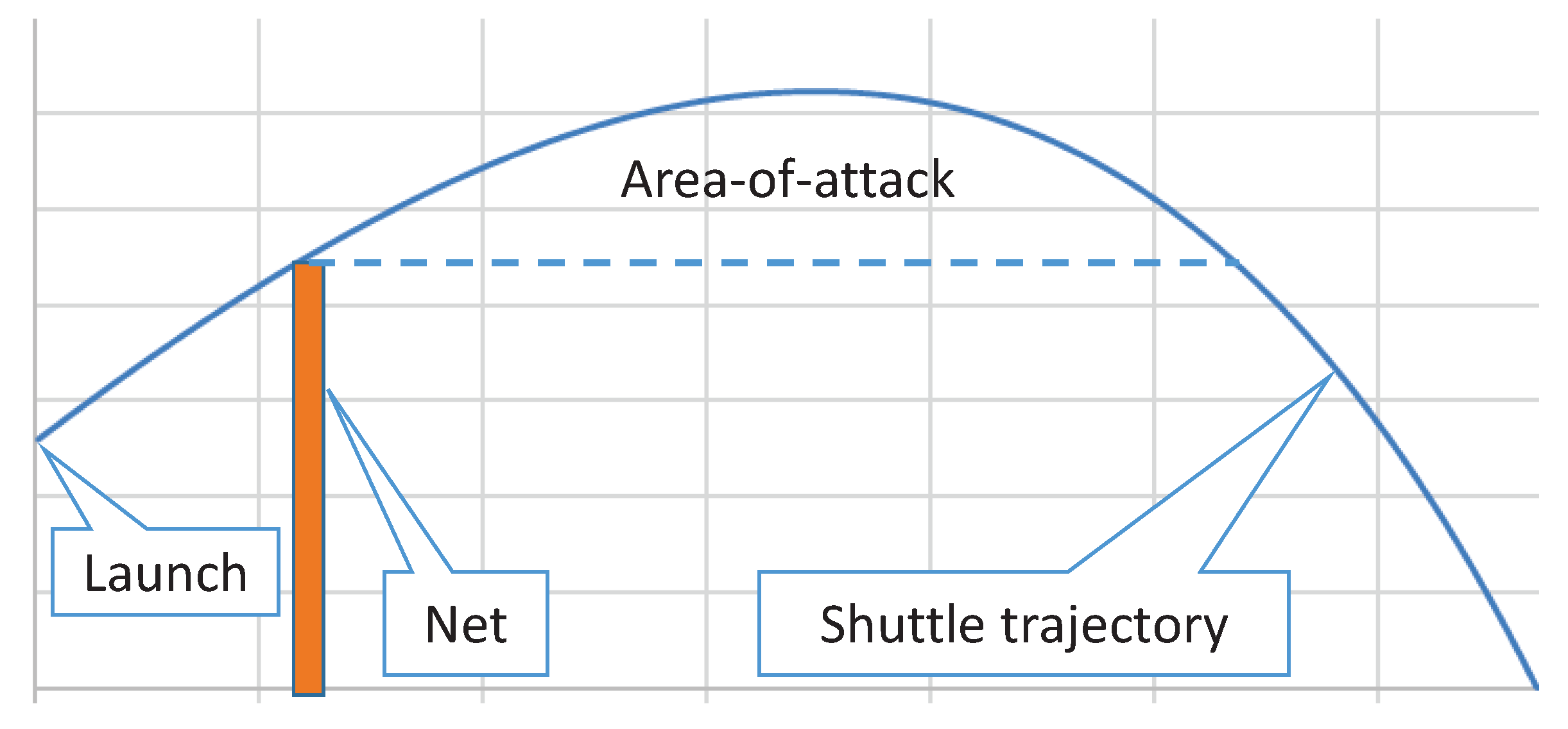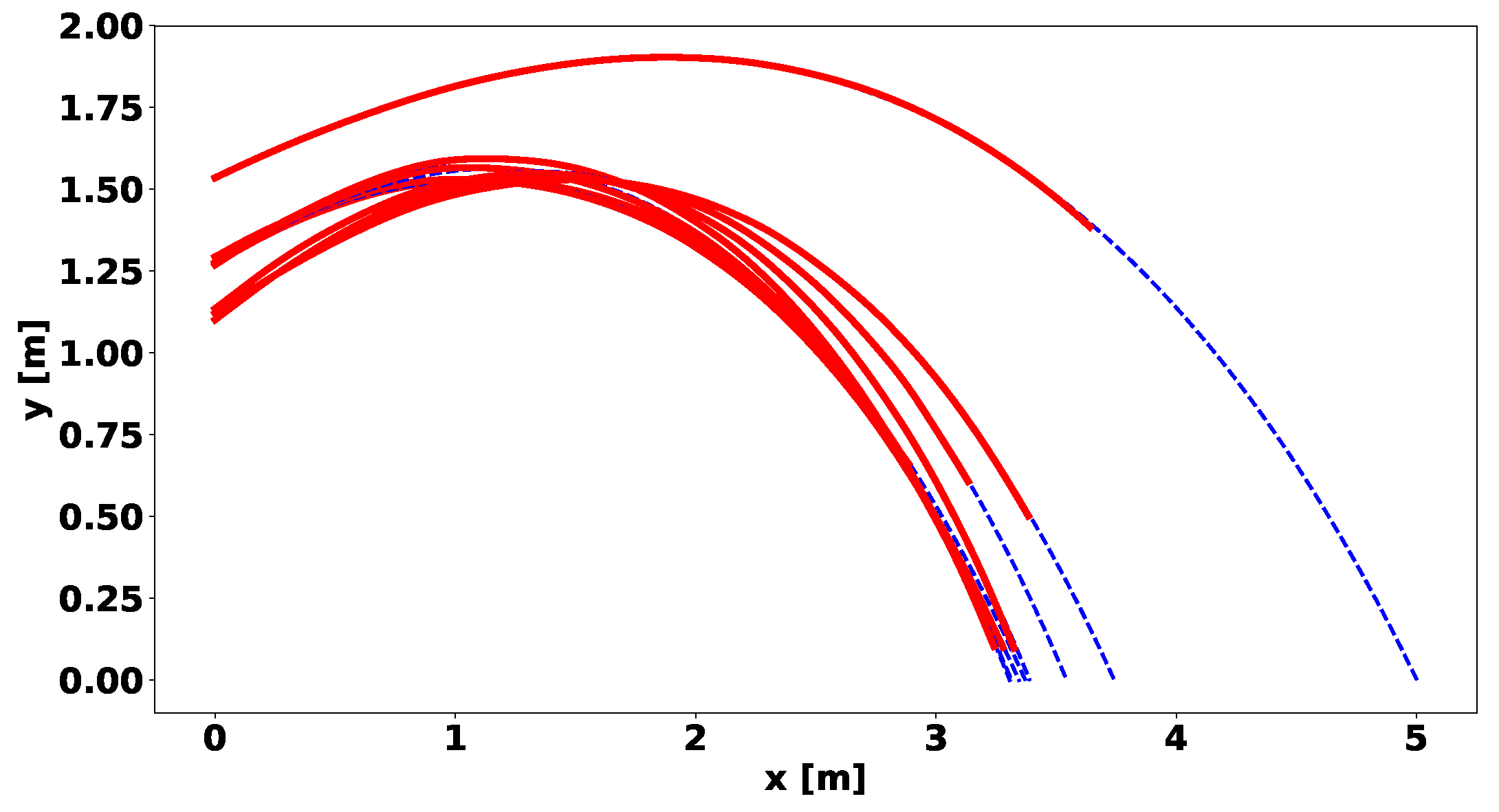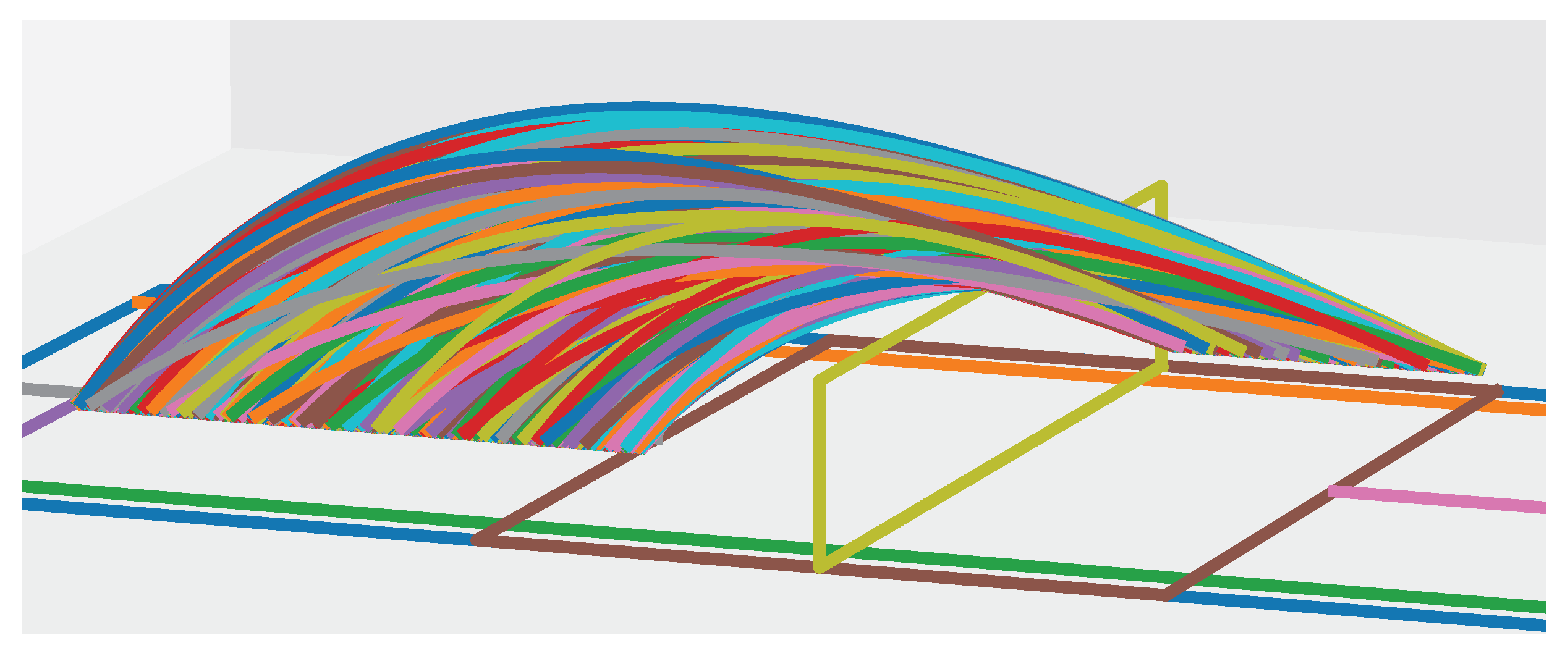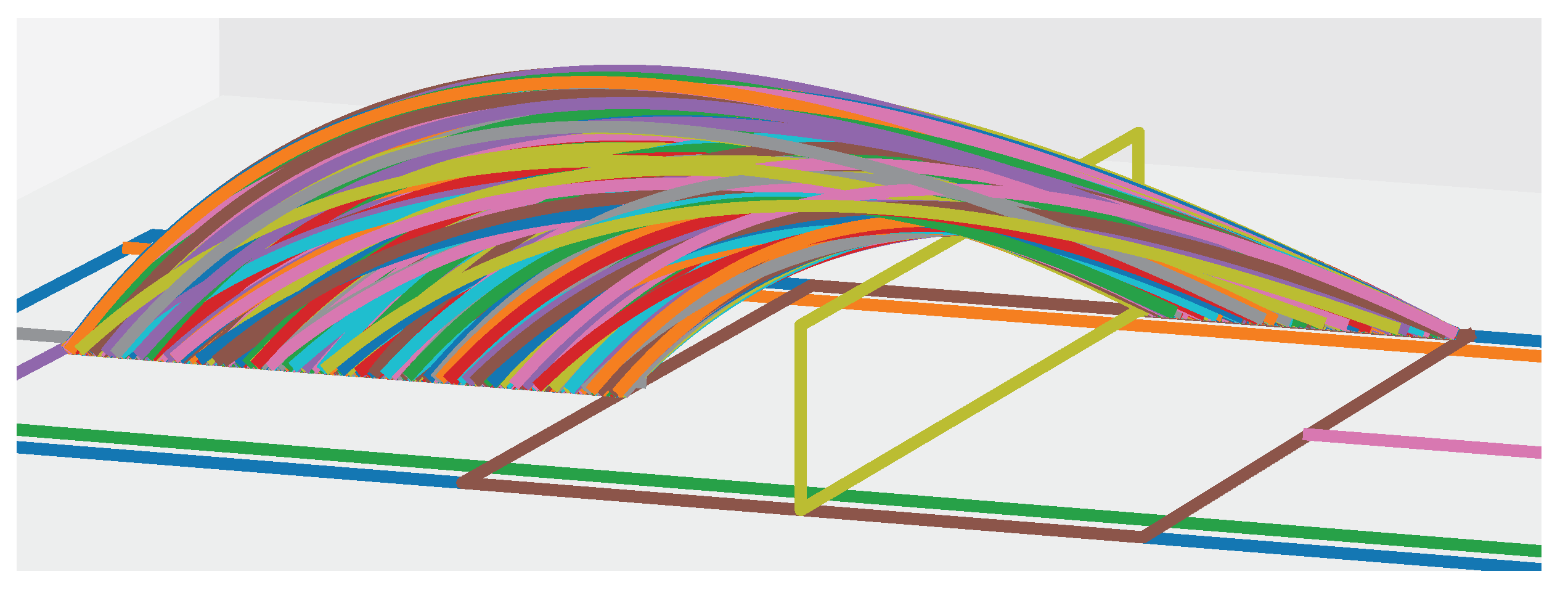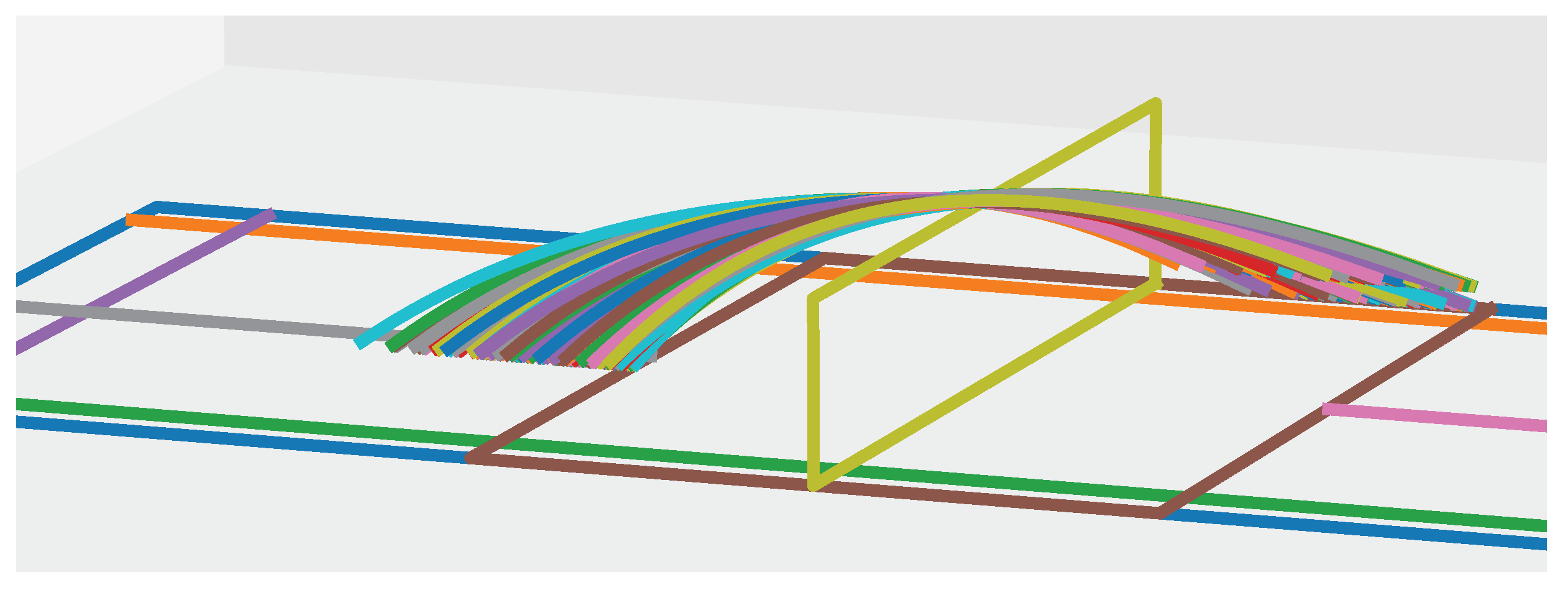1. Introduction
In badminton, each rally begins with a serve. The server’s feet are placed inside the service box, at a minimum distance of m to the net, and the shuttlecock must land inside the diagonally opposite service box on the receiver’s side after clearing the net height of m. The game has evolved such that most serves in singles and, in particular, in doubles are short serves. In doubles, the server’s feet are placed at the corner of the service box close to the middle of the court and close to the net, and the target of the serve is often the near corner of the receiver’s service box; i.e., the shortest possible flight trajectory. The server will typically perform the serve with the arms extended in front of the body to approach the launch position to the net and further minimize the length of the flight trajectory.
In this situation, the launch height becomes an important factor, with a larger height enabling a flatter serve and minimizing the opportunity of the receiver to attack the serve. Therefore, the classical rules of the serve constrain the position of the racket head at impact with the shuttlecock to be below the lower rib of the player. This means that taller players are able to launch the shuttlecock from a higher position than players of smaller statures.
In 2018, the Badminton World Federation (BWF) decided to experimentally change the rules of the serve and introduced a new limitation formulated as follows: “The whole of the shuttle shall be below 1.15 m from the surface of the court at the instant of being hit by the server’s racket” [
1]. To assist in the enforcement of the rule, the BWF also introduced a new apparatus by which the service judge can verify visually that the maximum launch height is not exceeded.
This rule was put in place for the first time during the All England Open Badminton Championships 2018 and sparked much controversy among players. The frame of reference for the launch position changed from a relative measure with respect to the server’s rib cage to an absolute measure with respect to the court. While no official explanation was provided, the rule change likely reflected a desire not to disfavor players with smaller statures. The new rule means that taller players must lower their launch position, while some shorter players can raise theirs, and the point of the controversy is whether a relative or an absolute measure is more fair.
The serving situation, particularly in doubles, is stressful because it is easy to attack the serve, and so the serving team will often find themselves in a defensive situation; thus, the serving height influences the balance of the game.
The purpose of this investigation was to provide quantitative measures for the influence of serve height. More precisely, we aimed to answer the following research questions:
How much lower is the new launch position compared with the old one for a particular world-class female doubles player, for whom the rule change has required an unwelcome adjustment?
Can we quantify the effect of the change in launch position on serve quality?
Are there under-exploited serve strategies that may come into play in light of the new serve rule?
As a by-product of the investigations, we also identified aerodynamic parameters for the numerical simulation of shuttlecock flight trajectory at Reynolds numbers typical for short serves.
Previous works on shuttlecock trajectory simulation are limited but have successfully simulated flight trajectories. Texier et al. [
2] noted that the flight of a shuttlecock is influenced by drag and different from a theoretical parabola. The subject of different material choices (plastic versus natural feathers) has attracted some attention, and Cooke [
3] developed a simulation based on aerodynamic measurements [
4] for the flight of different types of shuttlecocks and found agreement with experimental results. Chan and Rossmann [
5] investigated a variety of designs and simulated their trajectories based on aerodynamic measurements.
Chen et al. [
6] developed an analytical model of the trajectory based on easily quantifiable measures such as the terminal speed of a freely falling shuttlecock as described by Peastrel et al. [
7].
McErlain-Naylor et al. [
8] fitted a model based on simplified mechanical principles to measure motion capture data of the shuttlecock trajectories of overhand smashes by international badminton players to investigate the effect of the impact location of the shuttlecock on the racket on the shot outcome for badminton smashes. The observed shuttlecock velocities post-impact were 82.1 m/s on average, which is much higher than for serving.
The aforementioned works document that shuttlecock trajectory simulation is feasible but sensitive to input parameters, among which are shuttlecock designs and the physical conditions such as temperature and humidity. We therefore developed a model and calibrated it with experimental serve data for a particular shuttlecock to seek answers to the research questions.
2. Materials and Methods
2.1. Experiments
One female badminton player, with a stature of
m and a BWF doubles top-five ranking, was recruited for the experiment. A badminton court with official dimensions [
1] was established in a motion capture lab equipped with an eight-camera Qualisys Oqus system operating at 500 Hz. A tournament-grade feathered shuttlecock of brand Forza was stained with retro-reflective paint on the cork to allow tracking by the infra-red cameras. The mass of the stained shuttlecock was measured to 6.20 g.
The test subject performed regular doubles serves to different court targets; i.e., predominantly short serves. The serves were first performed according to the old serve rule—i.e., keeping the racket head under the test subject’s lower rib—and subsequently according to the new rule—i.e., launching the shuttlecock from below m in height. In the latter case, the launch position was verified with an authorized apparatus manufactured and provided by the Badminton World Federation. Shuttlecock cork trajectories were recorded and stored on C3D files by the motion capture system. The recorded trajectories were used to distinguish launch positions and calibrate the aerodynamic parameters. Initial data processing was performed by importing C3D files into the AnyBody Modeling System (AnyBody Technology, Aalborg, Denmark), where the trajectory was interpolated and re-sampled, and the launch positions and launch velocity vectors were computed.
2.2. Numerical Model
The equations of motion for the ballistic flight of a shuttlecock in its vertical plane of motion are
where
m/s
is the gravity acceleration vector,
m is the shuttlecock mass and
is the acceleration vector. The buoyancy force was neglected.
The drag force was computed as
where
kg/m
is the air density,
is the velocity vector of the shuttlecock,
is the drag coefficient and
A is the cross-sectional area of the shuttlecock.
The shuttlecock was assumed to be axisymmetric about its velocity vector and to fly with its axis parallel to the velocity vector, resulting in the absence of lift forces.
The Reynolds number of the flight trajectory is
where
m is the diameter of the shuttlecock, and
kg/ms is the viscosity of air.
Equation (
1) is a second-order ordinary differential equation, which we solved by numerical time integration using a fourth-order Runge–Kutta approach implemented in Python. Given the launch position and launch velocity vector as initial conditions, the time integration ran until the
y coordinate of the shuttlecock reached zero, at which point the landing position was recorded.
In the absence of lateral forces on the shuttlecock, the flight trajectory is two-dimensional, and it therefore was simulated in a 2D coordinate system. After simulation, the trajectory was rotated into its spatial direction given by the launch velocity vector.
2.3. Model Calibration
Equation (
2) represents an empirical approximation to a complex flow phenomenon governed by the Navier–Stokes equations. Drag on an object is caused by a combination of (a) friction between the object and the surrounding fluid related to the velocity gradient in the boundary layer and (b) the pressure difference between the upstream and downstream sides of the object related to turbulence in the fluid. In case (a), the drag force is proportional to the flight velocity—i.e.,
—and in case (b), it is proportional to the square of the velocity—i.e.,
. Derivations of these basic dependencies are available in many textbooks; for instance, [
9]. The shuttlecock has a complex geometry and is not airtight, so it may harbor regions of flow dominated by either (a) or (b). When calibrating
and
A simultaneously with all the recorded flight trajectories, the results were unsatisfactory when assuming either (a) or (b). An alternative approach would be to include two terms in the drag equation representing (a) and (b), respectively, and require the identification of two corresponding drag coefficients, say
and
. However, the model also calibrates accurately to a constant, non-integer
p. This has the advantage of retaining a single value for
for identification, albeit with the disadvantage of
not being dimensionless but having the unit
.
Directly after impact with the racket, the shuttlecock tumbles and turns in the air before it stabilizes into its flying position with the cork leading. This behavior made the recording of the initial velocity vector from the motion capture data subject to considerable uncertainty. Therefore, initial velocity vectors were also subjects of calibration.
Parameters
,
and
A multiply to form a common proportionality constant in Equation (
2), making their respective influences indistinguishable. Thus, only
was included in the calibration, and it effectively contained adjustments for
and
A as well.
Calibration was formulated as the following optimization problem:
where
is the number of empirical trajectories,
, available to calibrate the model,
spans from
to
.
are the simulated trajectories. The initial velocity vectors corresponding to the trajectories are labelled
. With eight initial velocity vectors, each comprising two coordinates, and two unknown physics parameters,
and
p, the calibration problem in Equation (
4) comprised a total of 18 variables.
2.4. Statistical Simulation
One Monte Carlo simulation was performed for each of the identified mean serve heights using the calibrated aerodynamic properties. In the interest of finding attractive serve strategies that are different from the accepted approach, the random number generator used uniform distributions within rather wide intervals. The launch velocity was picked randomly in the range of 4–20 m/s, the launch angle was in the range of 10–30 degrees, and the launch distance to the net was in a range of 1 m on each side of the service line.
Simulated serves that hit the net or landed out of bounds were discarded. The simulation continued until 5000 good serves were recorded for each condition.
The quality of each serve was subsequently evaluated by means of the area-of-attack, defined as the area of the trajectory that was over the net height on the receiver’s side, as illustrated in
Figure 1. Serves with an area-of-attack below 2% of the mean were placed in a pool of excellent serves for further assessment.
The area-of-attack alone might not be a fully representative metric for the quality of a serve. It can be argued that the time-of-travel of the shuttlecock to the point where the receiver can reach it is also important. Thus, for the selected excellent serves, the time-of-travel until the shuttlecock was 1 m beyond the net on the receiver’s side was computed and correlated against the launch position to reveal possibilities for alternative serve strategies.
4. Discussion
The number of successfully recorded trials was lower than originally planned due to unexpected difficulties in the tracking of the stained shuttlecock. A better statistical foundation for establishing the effective launch heights would be desirable.
4.1. Calibration
The calibrated trajectories presented in
Figure 2 indicate that the model was capable of simulating the flight trajectory with good accuracy within the investigated range of Reynolds numbers. It was remarkable that the drag was proportional to the velocity in a power of
, when
is often assumed. This indicates that a significant portion of the drag on a badminton shuttlecock at low velocities derives from friction.
Cooke [
4], by means of wind tunnel experiments, found a stable
around
for a Reynolds number interval of
, albeit with a different definition of the cross-sectional area of the shuttlecock, supporting the assumption of
. Chan and Rossmann [
5] found drag coefficients around
and Texier et al. [
2] measured
up to
.
Apart from different cross-sectional area definitions, the difference in these findings may be due to the low-velocity interval of the present investigation, to a different air density or viscosity, to increased drag caused by the axial rotation of the shuttlecock [
10] or to not considering the lift effect and increased drag caused by the deviation of the shuttlecock’s centre axis from its velocity vector. Hasegawa et al. [
11] observed, after conducting wind tunnel experiments, that “the value of drag coefficient for a shuttlecock without gaps is significantly smaller than that for a standard shuttlecock”. They found that the flow of air through the feathers into the shuttlecock increased the drag. In the present investigation, this flow in confined spaces may be a contributor to the friction part of the drag.
The findings cannot be extrapolated to higher-velocity strokes such as clears and smashes without further investigation, but the simulated trajectories indicate that the simulation is valid for the investigated case.
The added paint on the shuttlecock cork increased the mass of the shuttlecock by some fractions of a gram and offset the center-of-mass, which may have led the experimental data to deviate from unstained shuttlecocks.
4.2. Monte Carlo Simulation
The visual impression of excellent serves in terms of the area-of-attack (
Figure 5) indicates that this criterion is relevant in terms of the nature of the sport. Of these 190 serves, a small majority of 57% were launched from the old position, indicating that the new serve position makes it slightly harder for the tested player to perform excellent serves. This notion is corroborated by the finding that really excellent serves in terms of time-of-flight were predominantly launched from the old position (
Figure 6).
The time-of-flight investigation revealed, surprisingly, that a short time-of-flight is only weakly dependent on the proximity of the launch position to the net, and that there were excellent serves with a short time-of-flight launched from further back in the court. This indicates that there might be under-exploited serve strategies from positions further back in the court.
We can expect that taller players will be more affected by the rule change, and that the new rule may be a significant benefit for very short players.
The validity of the statistical approach for the case at hand can be debated. An alternative method could be the optimization of serve quality as a function of the free parameters, similar to the approach by Sørensen and Rasmussen [
12] for association football. If successful, such an approach would determine the best serve for each of the two conditions, and they could subsequently be compared. Realistic optimization, however, would require the consideration of sensitivity to noise in the neuromuscular system, as discussed by McErlain-Naylor et al. [
13], and the difficulty of learning a new movement pattern in order to cope with the new serve height. The strategy of the elite player in the present study, when serving from the uncustomary lower height, was to flex her knees to retain the familiar movement pattern in her upper body. The statistical model of the present study revealed that there were many serves of almost identical quality launched from very different positions. In this situation, the statistical opportunity to perform a good serve is more important than finding the absolute optimum.
5. Conclusions
Every branch of elite sports is a highly optimized activity. Without doubt, this is also the case for badminton and may be the reason why the new serve rule has been met with much criticism by several top players.
The simulations show that the new rule does indeed disadvantage tall players to some extent. However, it is likely that tactical modifications and the learning of new techniques will gradually soften the consequences for the affected players and perhaps lead to the advent of new serve strategies.
In a wider perspective, the flight of objects is important in many branches of sport. Serves are an integral part of the game in volleyball, squash, table tennis and tennis. In each of these sports, the serve is subject to tactical choices and can decide the match. In tennis, the serve is considered the most important stroke [
14], and elite players use combinations of speed, spin and placement to optimize the outcome of their serves. Although the aerodynamics of spinning tennis balls is different from that of badminton shuttlecocks, the tactical considerations concerning the risk of failed serves and the opponent’s ability to return the serve are similar. A combined numerical/statistical simulation similar to the approach presented in this paper may be used to elucidate beneficial tactical choices in tennis and possibly in other sports as well.
